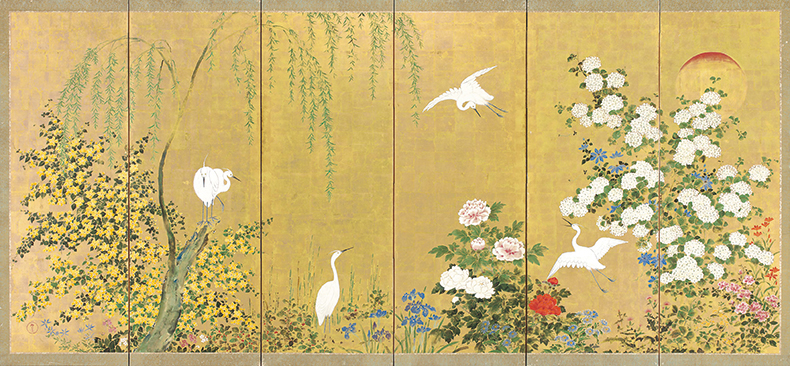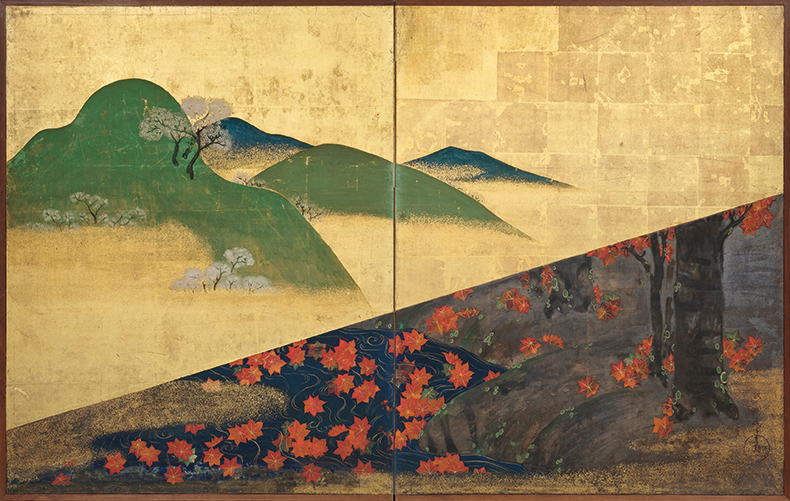From the February 2023 issue of Apollo. Preview and subscribe here.
The Rinpa (or Rimpa) style of painting (literally, ‘school of Rin’) is named in honour of the painter Ogata Korin (1658–1716) – who played a critical role in consolidating this tradition, though relatively speaking he was a latecomer to it. Rinpa is not a conventional ‘school’ of masters and pupils but instead an aesthetic tradition, periodically rediscovered, which can be traced back to medieval Japan. Rinpa works are characterised by their stylised, two-dimensional and usually vividly coloured representations of natural features such as birds and flowers on gold-leaf backgrounds, as well as by the use of certain techniques. Notable among these are mokkotsu (or ‘boneless’ depictions, without outlines) and tarashikomi (‘puddling’ ink or pigment on still-wet areas of paler colour).
The potter and calligrapher Koetsu Hon’ami (1558–1637) and the painter Tawaraya Sotatsu (died c. 1640), who worked together at the beginning of the Edo Period (1603–1867), are now generally accepted as the founders of the style. Hon’ami and Sotatsu, who were both upper-class merchants in Kyoto, collaborated on refined, decorative paintings that evoked the courtly poetry and literature – notably The Tale of Genji and The Tales of Ise – as well as the yamato-e painting of the much earlier Heian period (794–1185). As John Carpenter, curator of ‘Designing Nature: The Rinpa Aesthetic in Japanese Art’ at the Metropolitan Museum of Art in 2012–13, puts it in the catalogue: ‘Rinpa always operated in a nostalgic mode.’
The early Edo period was one of cultural renaissance after the tribulations of the Sengoku (‘Warring States’) period before it, and works in the nascent Rinpa style – screens, hanging scrolls, ceramics, textiles, lacquer-ware and even cloisonné enamels – won favour both with imperial patrons and the newly ambitious samurai elite in Edo (now Tokyo). Works were not signed, so it is hard to distinguish Sotatsu’s work from that of his studio; two seals associated with his Tawaraya workshop in Kyoto, called I’nen and Taiseiken, were passed down to important followers such as Tawaraya Sosetsu and Kitagawa Sosetsu (both active c. 1639–50).
Later in the 17th century, Ogata Korin took the style and reinforced its decorative appeal with his compelling compositions, characterised by their distinctive wave patterns and sinuous plant forms. The American scholar Ernest Fenollosa, who visited Japan in the late 19th century and subsequently introduced many of these painters into major American collections, wrote: ‘It is in this sense that we can call the chief masters of this Korin school the greatest painters of tree and flower forms that the world has ever seen. With them, these by us somewhat despised subjects rise to the dignity and divinity with which Greek art revealed the human figure.’
Ogata Korin’s younger brother, Ogata Kenzan, played a significant role in adapting the Rinpa style for the creation of ceramics. Other major followers of Korin include Sakai Hoitsu (1761–1828) and his pupil, Suzuki Kiitsu (1796–1858). Secure attribution is difficult because the subject matter is essentially conservative – imitation, and the repetition or reinterpretation of motifs among followers and admirers. was commonplace. As Carpenter writes: ‘Every generation of patrons, collectors, and other cognoscenti has formed its own collective consensus over what belongs or does not belong to each artist’s respective corpus.’ The late 19th century saw a further surge of interest in Rinpa painting among artists and collectors in Japan, while Rinpa influence can be seen in the development of art nouveau.
‘Rinpa is the biggest buzz word in Japanese painting today,’ according to Gregg Baker, a specialist dealer in Japanese screens based in Brussels. Collectors ‘want something really minimal, very bold and graphic’, he adds. Baker has sold Rinpa screens for $5,000 and for $500,000; he notes that the 17th-century screens fetch the highest prices and that secure attributions to any of the early leading figures are sure to increase the value. Baker describes the market as both solid and truly international, with the finest examples just as sought-after in New York as in Tokyo.
Screen (one of a pair; 18th century), Rinpa school. Sotheby’s London, £56,250 (for the pair)

Jon Adjetey, a specialist in the Japanese works of art department at Sotheby’s London, suggests that a pair of folding screens from the 17th century – if they are in something close to their original condition, and if they have been published – might fetch £200,000 to £300,000; such a figure remains, at least for the moment, strictly hypothetical, since works of this quality are like hen’s teeth, and when they do appear they are more likely to be sold on the private market. Equivalent pieces from the 18th century, Adjetey says, would fetch a tenth of that. In May 2019, the auction house sold a pair of 18th-century screens, bearing the I’nen seal, for £56,250 on a £20,000–£30,000 estimate.
Takaaki Murakami, head of the Japanese and Korean art department at Christie’s New York, notes that ‘Historically, the United States has been the strongest place for collecting, but we are now in a transitional phase where we see collectors from around the world, especially Asia […] The artists the market is most interested in,’ Murakami continues, are Tawaraya Sotatsu, Ogata Korin, and Suzuki Kiitsu; he notes that an exhibition celebrating the 350th anniversary of Korin’s birth in 2008, at the National Museum of Japan in Tokyo, ‘did inspire collectors’. Prior to that, the long shadow of Japan’s economic crisis in the 1990s put a dampener on the market.
Six-panel screen with ‘flowers of the four seasons’ motif (18th century), Rinpa school. Christie’s New York, $90,000

Subject matter is less important than condition – and works with both good condition and an important early name are incredibly rare. A pair of Rinpa school six-panel screens from the 18th century, marked with the I’nen seal and in excellent condition, sold at Christie’s New York for $90,000 in 2006 (estimate $60,000–$80,000). Similarly, a two-panel screen depicting flowers and grasses from the studio of Tawaraya Sotatsu, with I’nen seal, fetched $93,750 at Christie’s in 2016 (estimate $70,000–$90,000). In 2019, at the same auction house, a vivid ink sketch of three deer by Korin, with his seal, mounted on a painting of bush clover by Kiitsu, achieved $87,500 (estimate $30,000–$40,000).
Joan Mirviss, a leading New York dealer in Japanese art, agrees that ‘condition is critical.’ She adds that while Europeans are more concerned about the beauty of the image, Americans are more focused on attribution: ‘If it is Korin at his best, the sky is the limit.’ Then there are the diverging priorities of institutions and private collectors. Museums, looking with a curatorial eye, will be interested in connections between works and the stories to which the paintings allude. ‘Private collectors,’ by contrast, ‘want the iconic subject matter for which that artist is known – whether irises or morning glory.’ From the 1960s–80s, Mirviss was instrumental in advising on the creation of a number of major collections of Rinpa works – including that of Robert and Betsy Feinberg, who in 2013 promised more than 300 works of Japanese art to Harvard Art Museums. But Mirviss suggests that, today, ‘There isn’t a new generation of collectors at that level […] Being beautiful is helpful; being intellectually interesting is the kiss of death.’ Still, Mirviss has available a pair of hanging silk scrolls, painted in ink and colour by Suzuki Kiitsu, depicting blue morning glories paired with blossoming bottle gourd vine, for $60,000. A two-fold screen depicting a hillside, blossoming plum trees and maple leaves, by Kiitsu’s pupil Nakano Kimei (1834–92) is available for $38,000.
Two-fold screen (c. 1870–80), Nakano Kimei. Joan B. Mirviss, $38,000

From the February 2023 issue of Apollo. Preview and subscribe here.



